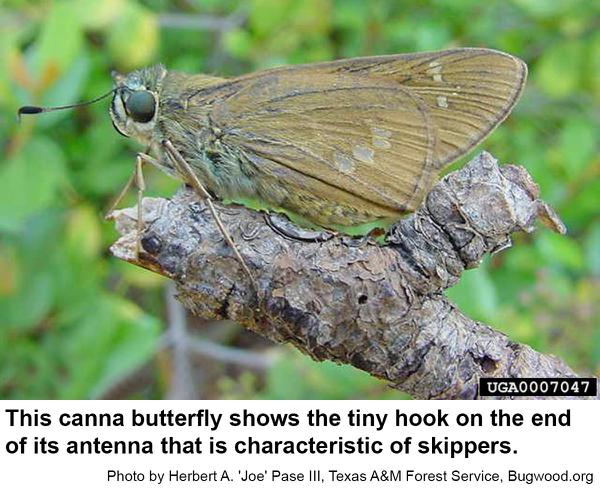Description and Biology
The larger canna leafroller, Calpodes ethlius, is a caterpillar in the family of butterfly-like insects called skippers. These brownish insects are common on flowers during the summer as they dart from flower to flower with a snapping sort of flight. This is also the family of the worm, Aegiale hesperiaris, that is used in tequila to assure the concentration of alcohol is up to standard. The skipper of the larger canna leafroller is called the Brazilian skipper, the canna butterfly, or the arrowroot butterfly. In North Carolina the larger canna leafroller seems to be a relatively minor pest of cannas (as compared to the lesser canna leafroller which may cause major damage to whole beds of cannas season after season). Larger canna leafroller skippers lay tiny, pale, dome-shaped to spherical, bluish green eggs on canna from which hatch tiny, pale caterpillars with black heads. These immediately cut and tie parts of a leaf to form a shelter. They remain within the rolled leaf except to feed. As they feed, molt, and grow, they create new, larger tubes. Larger canna leafrollers are relatively large (up to two inches long), pale green but translucent caterpillars with dark orange heads and short, distinct necks. They fold over a piece of the edge of a leaf and chew large, ragged chunks away from the remaining leaf. Within the folded leaf in a thin, white cocoon they eventually form a slender pupa that is pointed on each end. We have at least two generations per year in North Carolina although it is doubtful that larger canna leafrollers can survive winters north of southern Florida.
Host Plants
Larger canna leafrollers infest all species of canna as well as the related West Indian arrowroot and alligator flag. Cannas with red leaves and red or orange flowers are particularly attractive as host plants for canna butterflies.
Residential Recommendations
Sevin, Bacillus thuringiensis or some other contact insecticide should give adequate control if sprayed into the rolled portions on canna leaves. These leafrollers can also be squashed within their rolls or removed by hand or if one has the stomach for it.
References
- Insects and Other Arthropods That Feed on Aquatic and Wetland Plants. Center, T. D., et al. 2002. USDA, ARS Technical Bulletin 1870.
- Butterflies of Virginia. Clark, A. H. and L. F. Clark. Smithsonian Misc. Collections 116 (7). 287 pp.
- Common name: larger canna leafroller, scientific name: Calpodes ethlius (Stoll) (Insecta: Lepidoptera: Hesperiidae). McAuslane, H. J. and K. King. 2007 (revised). Featured Creatures. Entomology & Nematology, FDACS/DPI, EDIS. Publication Number: EENY-132.
- NC State Extension Plant Pathology Publications
- NC State Extension Horticultural Science Publications
- North Carolina Agricultural Chemicals Manual
For assistance with a specific problem, contact your local Cooperative Extension center.
This factsheet has not been peer reviewed.
Publication date: Dec. 20, 2016
Reviewed/Revised: March 9, 2022
Recommendations for the use of agricultural chemicals are included in this publication as a convenience to the reader. The use of brand names and any mention or listing of commercial products or services in this publication does not imply endorsement by NC State University or N.C. A&T State University nor discrimination against similar products or services not mentioned. Individuals who use agricultural chemicals are responsible for ensuring that the intended use complies with current regulations and conforms to the product label. Be sure to obtain current information about usage regulations and examine a current product label before applying any chemical. For assistance, contact your local N.C. Cooperative Extension county center.
N.C. Cooperative Extension prohibits discrimination and harassment regardless of age, color, disability, family and marital status, gender identity, national origin, political beliefs, race, religion, sex (including pregnancy), sexual orientation and veteran status.






